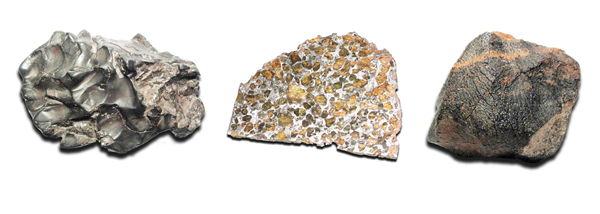Michale Olsen
Leaf River, Illinois
A: The three major types of meteorite (stony, stony-iron, and iron) cover a wide range of densities, from the least dense stony meteorites (roughly 2 to 3 grams per cubic centimeter), which have densities similar to some rocks from Earth, to the very dense iron meteorites (7 to 8 g/cm3). Although they only account for about 5 percent of meteorite falls, iron meteorites are more easily recognized than other types of meteorite
because they are so heavy.
The processes by which small grains stick together and accrete into small bodies are not well understood, and it is an area of active research and debate. Gravity isn’t the only force that attracts bodies to one another. Electrostatic forces, which pull together particles with opposite magnetic charges, may explain how small grains stuck together to form the first solids in the early solar system.
Iron is present in different amounts in all meteorites, obviously being most abundant in iron meteorites. All iron in planetary materials (including Earth) was inherited from the molecular cloud that collapsed to form our solar system and would have originally formed during nuclear fusion in massive stars.
All asteroids probably accreted from a mix of stony material, but the largest were able to undergo melting and differentiation to form a nickel-iron core and stony outer mantle, similar to the structure of Earth. Indeed, iron meteorites are thought to represent the nickel-iron metal cores of large asteroids that were disrupted and broken apart by impacts. Stony-irons (nearly equal mixtures of stony material and nickel-iron metal) may come from the boundary between the molten metal core and the outer silicate mantle. Stony meteorites come from a variety of different places in the solar system, including the Moon, Mars, and the asteroid belt. While some of these originated from bodies that differentiated (like the Moon, Mars, and large asteroids such as Vesta), many are remnants of asteroids that never grew large enough to undergo differentiation and remain largely unaltered since they formed over 4.5 billion years ago.
Jemma Davidson
Assistant Research Scientist, Center for Meteorite Studies,
Arizona State University at Tempe










